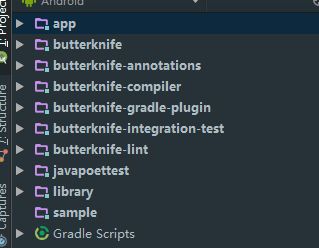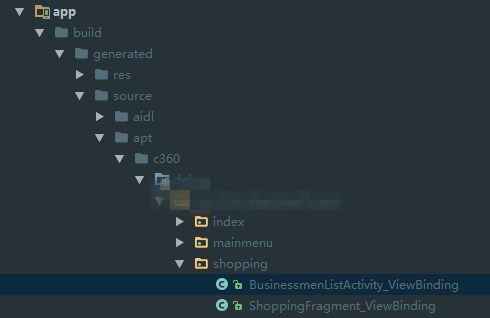一、前言
ButterKnife——通过注解的方式生成View字段、资源绑定和方法绑定的样板代码,是一款老司机书写UI布局的必备神器!自从有了ButterKnife,妈妈再也不用担心我findViewbyid(),find到手抽筋。
本文基于最新的8.7.0版本进行分析,不同版本可能实现方式有所差异,请知悉。
二、上车
下载Android studio 插件Android ButterKnife Zelezny,一键生成模板代码。更多姿势,请参考官方文档。作为一个老司机,上车不是我们的重点,漂移才是我们的目标!
三、漂移
checkout下来源码,工程结构如图,核心实现模块是butterknife、butterknife-annotations、butterknife-compiler。
首先从入口开始,以activity的bind为例,代码如下:
@NonNull @UiThread
public static Unbinder bind(@NonNull Activity target) {
View sourceView = target.getWindow().getDecorView();
return createBinding(target, sourceView);
}
先获取activity的根布局DecorView,然后作为参数传递给createBinding()方法,该方法就是通过构造函数new出一个“clsName + "_ViewBinding”的class对象。看一下createBinding()方法的关键代码:
private static Unbinder createBinding(@NonNull Object target, @NonNull View source) {
Class targetClass = target.getClass();
if (debug) Log.d(TAG, "Looking up binding for " + targetClass.getName());
Constructor constructor = findBindingConstructorForClass(targetClass);
if (constructor == null) {
return Unbinder.EMPTY;
}
//noinspection TryWithIdenticalCatches Resolves to API 19+ only type.
try {
return constructor.newInstance(target, source);
} catch (IllegalAccessException e) {
throw new RuntimeException("Unable to invoke " + constructor, e);
}
继续追踪 findBindingConstructorForClass()的源码:
@Nullable @CheckResult @UiThread
private static Constructor findBindingConstructorForClass(Class cls) {
Constructor bindingCtor = BINDINGS.get(cls);
if (bindingCtor != null) {
if (debug) Log.d(TAG, "HIT: Cached in binding map.");
return bindingCtor;
}
String clsName = cls.getName();
if (clsName.startsWith("android.") || clsName.startsWith("java.")) {
if (debug) Log.d(TAG, "MISS: Reached framework class. Abandoning search.");
return null;
}
try {
Class bindingClass = cls.getClassLoader().loadClass(clsName + "_ViewBinding");
//noinspection unchecked
bindingCtor = (Constructor) bindingClass.getConstructor(cls, View.class);
if (debug) Log.d(TAG, "HIT: Loaded binding class and constructor.");
} catch (ClassNotFoundException e) {
if (debug) Log.d(TAG, "Not found. Trying superclass " + cls.getSuperclass().getName());
bindingCtor = findBindingConstructorForClass(cls.getSuperclass());
} catch (NoSuchMethodException e) {
throw new RuntimeException("Unable to find binding constructor for " + clsName, e);
}
BINDINGS.put(cls, bindingCtor);
return bindingCtor;
}
该方法首先从BINDINGS这个LinkedHashMap中查找缓存,如果命中,直接返回bindingCtor,bindingCtor是实现了Unbinder接口的子类的构造函数;如果为null,则通过ClassLoade加载一个"clsName + "_ViewBinding""的类,然后返回其构造函数。其中clsName 就是我们上文调用bind()的activity,最后把它put到BINDINGS这个集合中。
那么"clsName + "_ViewBinding""的这个类在哪?里面实现了什么逻辑?又是怎么生成的?这些才是今天的重点!接下来我们一个个解答:
3.1 "clsName + "_ViewBinding""的这个类在哪?:
大家根据截图一层一层追进去就可以找到相应代码。大致是:app->build->generated->source->apt->"打包渠道"->clsName类在工程中所在目录
3.2 "clsName + "_ViewBinding""的这个类实现了什么逻辑?
如上所述,该类实现了Unbinder接口,有两个重载的构造函数,和一个unbind()方法,unbind()方法很简单,顾名思义就是解除绑定,释放资源,没啥好说的。
public class BusinessmenListActivity_ViewBinding implements Unbinder {
private BusinessmenListActivity target;
@UiThread
public BusinessmenListActivity_ViewBinding(BusinessmenListActivity target) {
this(target, target.getWindow().getDecorView());
}
@UiThread
public BusinessmenListActivity_ViewBinding(BusinessmenListActivity target, View source) {
this.target = target;
target.mRecyclerView = Utils.findRequiredViewAsType(source, R.id.rv_bus, "field 'mRecyclerView'", RecyclerView.class);
target.mRefreshLayout = Utils.findRequiredViewAsType(source, R.id.refresh_layout, "field 'mRefreshLayout'", SwipeRefreshLayout.class);
}
@Override
@CallSuper
public void unbind() {
BusinessmenListActivity target = this.target;
if (target == null) throw new IllegalStateException("Bindings already cleared.");
this.target = null;
target.mRecyclerView = null;
target.mRefreshLayout = null;
}
}
我们重点看一下Utils.findRequiredViewAsType()的代码,就是这个方法帮我们实现了绑定View相关逻辑。先调用findRequiredView()方法返回Viwe对象,然后再castView()成具体的子View。比较简单,直接看代码相信都能看懂:
public static T findRequiredViewAsType(View source, @IdRes int id, String who,
Class cls) {
View view = findRequiredView(source, id, who);
return castView(view, id, who, cls);
}
findRequiredView()代码:
public static View findRequiredView(View source, @IdRes int id, String who) {
View view = source.findViewById(id);
if (view != null) {
return view;
}
String name = getResourceEntryName(source, id);
throw new IllegalStateException("Required view '"
+ name
+ "' with ID "
+ id
+ " for "
+ who
+ " was not found. If this view is optional add '@Nullable' (fields) or '@Optional'"
+ " (methods) annotation.");
}
castView()代码:
public static T castView(View view, @IdRes int id, String who, Class cls) {
try {
return cls.cast(view);
} catch (ClassCastException e) {
String name = getResourceEntryName(view, id);
throw new IllegalStateException("View '"
+ name
+ "' with ID "
+ id
+ " for "
+ who
+ " was of the wrong type. See cause for more info.", e);
}
}
至此,就完成了View绑定的所有逻辑。
3.3 "clsName + "_ViewBinding"".java文件是如何生成的?
该类的生成主要依赖一个叫做APT的工具。APT(Annotation Processing Tool)是一种处理注解的工具,它对源代码文件进行检测找出其中的Annotation,使用Annotation进行额外的处理。
使用apt需要继承AbstractProcessor类,同时有几个核心方法需要实现,分别是:
init()主要做一些初始化操作;
getSupportedAnnotationTypes(),顾名思义,获取所有支持的注解类型;
process()处理注解相关逻辑,"clsName + "_ViewBinding"".java文件生成的核心逻辑就在这里!
在ButterKnife中,有一个ButterKnifeProcessor类,该类就是处理ButterKnife注解相关逻辑的类。
3.3.1 我们先从init()方法开始:初始化。
@Override public synchronized void init(ProcessingEnvironment env) {
super.init(env);
String sdk = env.getOptions().get(OPTION_SDK_INT);
if (sdk != null) {
try {
this.sdk = Integer.parseInt(sdk);
} catch (NumberFormatException e) {
env.getMessager()
.printMessage(Kind.WARNING, "Unable to parse supplied minSdk option '"
+ sdk
+ "'. Falling back to API 1 support.");
}
}
debuggable = !"false".equals(env.getOptions().get(OPTION_DEBUGGABLE));
elementUtils = env.getElementUtils();
typeUtils = env.getTypeUtils();
filer = env.getFiler();
try {
trees = Trees.instance(processingEnv);
} catch (IllegalArgumentException ignored) {
}
}
init()方法中,没有过多逻辑,只是有几个变量需要说明一下,这几个主要是注解处理时用到的工具类。
private Elements elementUtils;
private Types typeUtils;
private Filer filer;
private Trees trees;
Elements:一个用来处理Element的工具类,源代码的每一个部分都是一个特定类型的Element。例如,包名、字段、方法等等。
Types:一个用来处理TypeMirror的工具类,比如判断该元素是class还是interface;
Filer:生成文件;
Trees :树,遍历文件用到。
3.3.2 接下来看一下getSupportedAnnotationTypes()方法:获取所有支持的注解类型。
@Override public Set getSupportedAnnotationTypes() {
Set types = new LinkedHashSet<>();
for (Class annotation : getSupportedAnnotations()) {
types.add(annotation.getCanonicalName());
}
return types;
}
private Set> getSupportedAnnotations() {
Set> annotations = new LinkedHashSet<>();
annotations.add(BindAnim.class);
annotations.add(BindArray.class);
annotations.add(BindBitmap.class);
annotations.add(BindBool.class);
annotations.add(BindColor.class);
annotations.add(BindDimen.class);
annotations.add(BindDrawable.class);
annotations.add(BindFloat.class);
annotations.add(BindFont.class);
annotations.add(BindInt.class);
annotations.add(BindString.class);
annotations.add(BindView.class);
annotations.add(BindViews.class);
annotations.addAll(LISTENERS);
return annotations;
}
该方法的大概意思就是,将所有ButterKnife用到的注解全部添加到支持的注解集合中。
我们来瞄一眼最熟悉的BindView.class
@Retention(CLASS) @Target(FIELD)
public @interface BindView {
/** View ID to which the field will be bound. */
@IdRes int value();
}
代码很简单,但是有几个注解相关的点需要说明一下,
元注解:元注解的作用就是负责注解其他注解。相关元注解:
1.@Target:
表示注解类型所适用的程序元素的种类。
2.@Retention:
表示该注解类型的注解保留的时长。
SOURCE 仅存在Java源文件,经过编译器后便丢弃相应的注解;
CLASS 存在Java源文件,以及经编译器后生成的Class字节码文件,但在运行时VM不再保留注释;
RUNTIME 存在源文件、编译生成的Class字节码文件,以及保留在运行时VM中,可通过反射性地读取注解。
对应到BindView这个注解中,我们可以知道,该注解适用的类型为字段,且会打包到Class字节码文件中,该注解接收的值类型为@IdRes int类型。
3.3.3 最后process()方法:遍历所有注解->根据注解生成相应的代码->生成java文件。
@Override public boolean process(Set elements, RoundEnvironment env) {
Map bindingMap = findAndParseTargets(env);
for (Map.Entry entry : bindingMap.entrySet()) {
TypeElement typeElement = entry.getKey();
BindingSet binding = entry.getValue();
JavaFile javaFile = binding.brewJava(sdk, debuggable);
try {
javaFile.writeTo(filer);
} catch (IOException e) {
error(typeElement, "Unable to write binding for type %s: %s", typeElement, e.getMessage());
}
}
return false;
}
先瞄一眼findAndParseTargets()方法核心代码:
private Map findAndParseTargets(RoundEnvironment env) {
Map builderMap = new LinkedHashMap<>();
Set erasedTargetNames = new LinkedHashSet<>();
// ...... 此处省略若干行代码
// Process each @BindView element.
for (Element element : env.getElementsAnnotatedWith(BindView.class)) {
// we don't SuperficialValidation.validateElement(element)
// so that an unresolved View type can be generated by later processing rounds
try {
parseBindView(element, builderMap, erasedTargetNames);
} catch (Exception e) {
logParsingError(element, BindView.class, e);
}
}
}
// Associate superclass binders with their subclass binders. This is a queue-based tree walk
// which starts at the roots (superclasses) and walks to the leafs (subclasses).
Deque> entries =
new ArrayDeque<>(builderMap.entrySet());
Map bindingMap = new LinkedHashMap<>();
while (!entries.isEmpty()) {
Map.Entry entry = entries.removeFirst();
TypeElement type = entry.getKey();
BindingSet.Builder builder = entry.getValue();
TypeElement parentType = findParentType(type, erasedTargetNames);
if (parentType == null) {
bindingMap.put(type, builder.build());
} else {
BindingSet parentBinding = bindingMap.get(parentType);
if (parentBinding != null) {
builder.setParent(parentBinding);
bindingMap.put(type, builder.build());
} else {
// Has a superclass binding but we haven't built it yet. Re-enqueue for later.
entries.addLast(entry);
}
}
}
return bindingMap;
还是以@BindView 为例,其他的类似,不再一一赘述。关键代码:
// Process each @BindView element.
for (Element element : env.getElementsAnnotatedWith(BindView.class)) {
// we don't SuperficialValidation.validateElement(element)
// so that an unresolved View type can be generated by later processing rounds
try {
parseBindView(element, builderMap, erasedTargetNames);
} catch (Exception e) {
logParsingError(element, BindView.class, e);
}
}
}
遍历所有使用@BindView注解的Element,继续看parseBindView()代码:
private void parseBindView(Element element, Map builderMap,
Set erasedTargetNames) {
TypeElement enclosingElement = (TypeElement) element.getEnclosingElement();
// Assemble information on the field.
//获取绑定的View的id,即:R.id.xx.
int id = element.getAnnotation(BindView.class).value();
//判断该元素是否已经绑定过,如果绑定过,返回错误,否则,调用getOrCreateBindingBuilder()方法
BindingSet.Builder builder = builderMap.get(enclosingElement);
QualifiedId qualifiedId = elementToQualifiedId(element, id);
if (builder != null) {
String existingBindingName = builder.findExistingBindingName(getId(qualifiedId));
if (existingBindingName != null) {
error(element, "Attempt to use @%s for an already bound ID %d on '%s'. (%s.%s)",
BindView.class.getSimpleName(), id, existingBindingName,
enclosingElement.getQualifiedName(), element.getSimpleName());
return;
}
} else {
builder = getOrCreateBindingBuilder(builderMap, enclosingElement);
}
String name = simpleName.toString();
TypeName type = TypeName.get(elementType);
boolean required = isFieldRequired(element);
builder.addField(getId(qualifiedId), new FieldViewBinding(name, type, required));
// Add the type-erased version to the valid binding targets set.
erasedTargetNames.add(enclosingElement);
}
首先,通过 int id = element.getAnnotation(BindView.class).value();获取绑定的View的id,即:R.id.xx.;
再通过elementToQualifiedId()方法,生成一个合格标识:
private QualifiedId elementToQualifiedId(Element element, int id) {
return new QualifiedId(elementUtils.getPackageOf(element).getQualifiedName().toString(), id);
}
第三步,从已经绑定的元素中查找该元素是否存在,如果存在,返回错误,不允许重复绑定,否则调用getOrCreateBindingBuilder()方法生成一个绑定对象:
private BindingSet.Builder getOrCreateBindingBuilder(
Map builderMap, TypeElement enclosingElement) {
BindingSet.Builder builder = builderMap.get(enclosingElement);
if (builder == null) {
builder = BindingSet.newBuilder(enclosingElement);
builderMap.put(enclosingElement, builder);
}
return builder;
}
进一步看看 BindingSet.newBuilder(enclosingElement)方法
static Builder newBuilder(TypeElement enclosingElement) {
TypeMirror typeMirror = enclosingElement.asType();
boolean isView = isSubtypeOfType(typeMirror, VIEW_TYPE);
boolean isActivity = isSubtypeOfType(typeMirror, ACTIVITY_TYPE);
boolean isDialog = isSubtypeOfType(typeMirror, DIALOG_TYPE);
TypeName targetType = TypeName.get(typeMirror);
if (targetType instanceof ParameterizedTypeName) {
targetType = ((ParameterizedTypeName) targetType).rawType;
}
String packageName = getPackage(enclosingElement).getQualifiedName().toString();
String className = enclosingElement.getQualifiedName().toString().substring(
packageName.length() + 1).replace('.', '$');
ClassName bindingClassName = ClassName.get(packageName, className + "_ViewBinding");
boolean isFinal = enclosingElement.getModifiers().contains(Modifier.FINAL);
return new Builder(targetType, bindingClassName, isFinal, isView, isActivity, isDialog);
}
就是这里将生成的java文件类名定义为“className + "_ViewBinding"”
第四步,回到parseBindView()方法,为绑定对象添加绑定的View字段:
builder.addField(getId(qualifiedId), new FieldViewBinding(name, type, required));
第五步,关联父类绑定的资源(view、string、listener等),并把她们添加到 Map
BuildSet对象就是单个绑定类型(activity、fragment、view、dialog)的所有绑定请求(BindView、BindString等)的集合。每一个使用ButterKnife的类对应一个BuildSet。
// Associate superclass binders with their subclass binders. This is a queue-based tree walk
// which starts at the roots (superclasses) and walks to the leafs (subclasses).
Deque> entries =
new ArrayDeque<>(builderMap.entrySet());
Map bindingMap = new LinkedHashMap<>();
while (!entries.isEmpty()) {
Map.Entry entry = entries.removeFirst();
TypeElement type = entry.getKey();
BindingSet.Builder builder = entry.getValue();
TypeElement parentType = findParentType(type, erasedTargetNames);
if (parentType == null) {
bindingMap.put(type, builder.build());
} else {
BindingSet parentBinding = bindingMap.get(parentType);
if (parentBinding != null) {
builder.setParent(parentBinding);
bindingMap.put(type, builder.build());
} else {
// Has a superclass binding but we haven't built it yet. Re-enqueue for later.
entries.addLast(entry);
}
}
主要看一下关键代码 BindingSet build()代码,以及BindingSet的构造函数:
BindingSet build() {
ImmutableList.Builder viewBindings = ImmutableList.builder();
for (ViewBinding.Builder builder : viewIdMap.values()) {
viewBindings.add(builder.build());
}
return new BindingSet(targetTypeName, bindingClassName, isFinal, isView, isActivity, isDialog,
viewBindings.build(), collectionBindings.build(), resourceBindings.build(),
parentBinding);
}
private BindingSet(TypeName targetTypeName, ClassName bindingClassName, boolean isFinal,
boolean isView, boolean isActivity, boolean isDialog, ImmutableList viewBindings,
ImmutableList collectionBindings,
ImmutableList resourceBindings, BindingSet parentBinding) {
this.isFinal = isFinal;
this.targetTypeName = targetTypeName;
this.bindingClassName = bindingClassName;
this.isView = isView;
this.isActivity = isActivity;
this.isDialog = isDialog;
this.viewBindings = viewBindings;
this.collectionBindings = collectionBindings;
this.resourceBindings = resourceBindings;
this.parentBinding = parentBinding;
}
至此,所有需要绑定的资源已经添加到集合当中,只差生成代码,可谓万事俱备只欠东风!
回到process()代码:
@Override public boolean process(Set elements, RoundEnvironment env) {
Map bindingMap = findAndParseTargets(env);
for (Map.Entry entry : bindingMap.entrySet()) {
TypeElement typeElement = entry.getKey();
BindingSet binding = entry.getValue();
JavaFile javaFile = binding.brewJava(sdk, debuggable);
try {
javaFile.writeTo(filer);
} catch (IOException e) {
error(typeElement, "Unable to write binding for type %s: %s", typeElement, e.getMessage());
}
}
return false;
}
通过第一行代码,我们几经周折终于掌握了她的来龙去脉,还剩一个for循环。for循环无非就是遍历生成相应的"clsName + "_ViewBinding"".java文件,具体怎么生成的,我们跟进去瞄一眼:
JavaFile brewJava(int sdk, boolean debuggable) {
return JavaFile.builder(bindingClassName.packageName(), createType(sdk, debuggable))
.addFileComment("Generated code from Butter Knife. Do not modify!")
.build();
}
这里涉及一个重要的知识点:JavaPoet。此为何物? 套用官方的简介就是:“JavaPoet is a Java API for generating .java source files.” 简直精辟得不能再精辟!
简单理解——就是用来生成java文件的,这不正是我们所要的东风吗?具体的使用姿势,不是本文的重点,可以查看官方文档,文档写得相当详细,在此不再一一赘述,本文只对用到的地方做一些解析。
看一下createType()方法:
private TypeSpec createType(int sdk, boolean debuggable) {
TypeSpec.Builder result = TypeSpec.classBuilder(bindingClassName.simpleName())
.addModifiers(PUBLIC);
if (isFinal) {
result.addModifiers(FINAL);
}
if (parentBinding != null) {
result.superclass(parentBinding.bindingClassName);
} else {
result.addSuperinterface(UNBINDER);
}
if (hasTargetField()) {
result.addField(targetTypeName, "target", PRIVATE);
}
if (isView) {
result.addMethod(createBindingConstructorForView());
} else if (isActivity) {
result.addMethod(createBindingConstructorForActivity());
} else if (isDialog) {
result.addMethod(createBindingConstructorForDialog());
}
if (!constructorNeedsView()) {
// Add a delegating constructor with a target type + view signature for reflective use.
result.addMethod(createBindingViewDelegateConstructor());
}
result.addMethod(createBindingConstructor(sdk, debuggable));
if (hasViewBindings() || parentBinding == null) {
result.addMethod(createBindingUnbindMethod(result));
}
return result.build();
}
如果你已经了解了JavaPoet之后再来看这个代码,其实可以一目了然,这里不做过多解释,仅仅验证一下,我们的设想与生成的"clsName + "_ViewBinding"".java文件内容是否一致即可。
主要看一下createBindingConstructor()方法,该方法是生成"clsName + "_ViewBinding"".java代码的核心:
private MethodSpec createBindingConstructor(int sdk, boolean debuggable) {
MethodSpec.Builder constructor = MethodSpec.constructorBuilder()
.addAnnotation(UI_THREAD)
.addModifiers(PUBLIC);
if (hasMethodBindings()) {
constructor.addParameter(targetTypeName, "target", FINAL);
} else {
constructor.addParameter(targetTypeName, "target");
}
if (constructorNeedsView()) {
constructor.addParameter(VIEW, "source");
} else {
constructor.addParameter(CONTEXT, "context");
}
if (hasUnqualifiedResourceBindings()) {
// Aapt can change IDs out from underneath us, just suppress since all will work at runtime.
constructor.addAnnotation(AnnotationSpec.builder(SuppressWarnings.class)
.addMember("value", "$S", "ResourceType")
.build());
}
if (hasOnTouchMethodBindings()) {
constructor.addAnnotation(AnnotationSpec.builder(SUPPRESS_LINT)
.addMember("value", "$S", "ClickableViewAccessibility")
.build());
}
if (parentBinding != null) {
if (parentBinding.constructorNeedsView()) {
constructor.addStatement("super(target, source)");
} else if (constructorNeedsView()) {
constructor.addStatement("super(target, source.getContext())");
} else {
constructor.addStatement("super(target, context)");
}
constructor.addCode("\n");
}
if (hasTargetField()) {
constructor.addStatement("this.target = target");
constructor.addCode("\n");
}
if (hasViewBindings()) {
if (hasViewLocal()) {
// Local variable in which all views will be temporarily stored.
constructor.addStatement("$T view", VIEW);
}
for (ViewBinding binding : viewBindings) {
addViewBinding(constructor, binding, debuggable);
}
for (FieldCollectionViewBinding binding : collectionBindings) {
constructor.addStatement("$L", binding.render(debuggable));
}
if (!resourceBindings.isEmpty()) {
constructor.addCode("\n");
}
}
if (!resourceBindings.isEmpty()) {
if (constructorNeedsView()) {
constructor.addStatement("$T context = source.getContext()", CONTEXT);
}
if (hasResourceBindingsNeedingResource(sdk)) {
constructor.addStatement("$T res = context.getResources()", RESOURCES);
}
for (ResourceBinding binding : resourceBindings) {
constructor.addStatement("$L", binding.render(sdk));
}
}
return constructor.build();
}
大功告成!所有的逻辑执行完毕之后,就生成是我们3.2节对应的代码。
4、总结
祝各位司机漂移成功!

